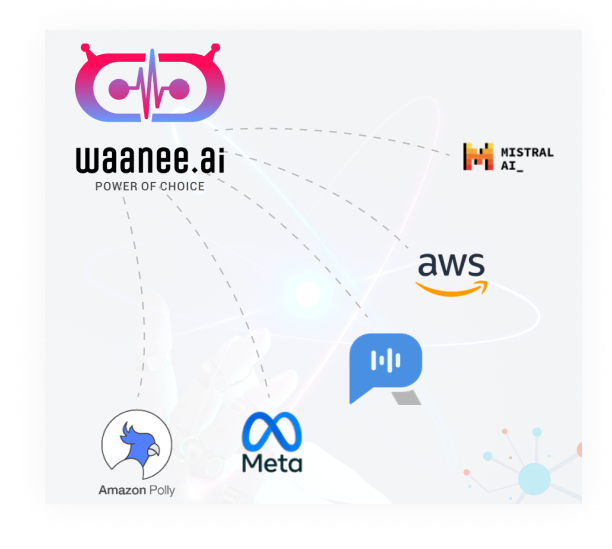
-
Waanee AI Labs
View All »

Get The Latest
How to Implement an Intent-Based IVR Without Disrupting Your Existing Call Flow
Read More »Checklist: What to Look for in a Post-Call Audit Solution Before You Buy
Read More »Post-Call Audit vs. Traditional QA: A Side-by-Side Comparison
Read More » - Blog
How to Implement an Intent-Based IVR Without Disrupting Your Existing Call Flow
Posted by Vishal Vanwari, on 26 Oct, 2025 08:07 AM

How to Implement an Intent-Based IVR Without Disrupting Your Existing Call Flow
Customer experience expectations have evolved dramatically. Today’s callers expect intelligent, conversational interactions rather than navigating through endless menu options. This is where intent-based IVR systems powered by artificial intelligence are revolutionizing customer service. However, many businesses hesitate to make the switch, worried about disrupting their carefully crafted call flows and frustrating existing customers during the transition.
The good news? You can implement an AI-powered IVR system smoothly without causing operational chaos. Here’s your comprehensive guide to making the transition seamless.
Understanding Intent-Based IVR Technology
Before diving into implementation, it’s crucial to understand what sets intent-based IVR apart from traditional systems. Unlike conventional touch-tone IVRs that force callers through rigid menu trees, an intent-based IVR uses natural language processing to understand what customers actually want. Callers can speak naturally, saying things like “I need to check my account balance” or “I want to talk about my bill,” and the system intelligently routes them to the right destination.
This AI-powered approach dramatically reduces caller frustration and decreases call handling time, but only when implemented thoughtfully.
Audit Your Current Call Flow
The foundation of a successful transition starts with thoroughly understanding your existing system. Map out every branch of your current IVR tree, documenting all menu options, routing rules, and transfer points. Identify which paths customers use most frequently and where they typically experience friction or abandon calls.
This audit reveals critical insights. You might discover that 70% of your calls funnel through just three menu options, or that customers frequently press zero to bypass your IVR entirely. These patterns become your roadmap for designing an AI-powered IVR that genuinely improves the customer experience.
Pay special attention to seasonal variations, peak call times, and any business logic that determines routing decisions. This comprehensive understanding ensures nothing gets lost in translation.
Start with a Parallel Testing Approach
Rather than replacing your entire system overnight, run your intent-based IVR parallel to your existing setup. This approach allows you to test the new system with real calls while maintaining your proven fallback option.
Begin by directing a small percentage of incoming calls—perhaps 10-15%—to the new AI-powered IVR. Monitor performance metrics closely: call resolution rates, customer satisfaction scores, average handling time, and transfer accuracy. This controlled environment lets you identify and fix issues before they impact your entire customer base.
Gradually increase the percentage of calls routed to the intent-based system as confidence grows. This measured approach minimizes risk while gathering valuable data about how customers interact with conversational AI.
Design Natural Language Intents
The power of intent-based IVR lies in its ability to understand diverse ways customers express the same need. When designing your intent library, think beyond rigid menu options. For example, customers might say “I need help with my bill,” “question about charges,” “why is my invoice so high,” or “billing issue”—all expressing the same underlying intent.
Work with your customer service team to identify common phrases and variations. Review call transcripts to understand actual customer language rather than assuming how they’ll communicate. Your AI-powered IVR should recognize dozens of variations for each core intent, making interactions feel natural and intuitive.
Group related intents logically and ensure your system can handle multi-intent queries where customers express multiple needs in one sentence.
Maintain Strategic Fallback Options
Even the most sophisticated intent-based IVR won’t perfectly understand every caller every time. Building robust fallback mechanisms is essential for customer satisfaction. When the system doesn’t confidently understand a customer’s intent, it should gracefully offer alternatives rather than guessing incorrectly.
Keep your traditional menu options available as a fallback. If the AI-powered IVR asks “How can I help you today?” and receives ambiguous responses after two attempts, offer a simple menu: “Press 1 for billing, press 2 for technical support, press 3 for new service.”
Always provide an immediate path to human agents. Customers who repeatedly struggle with any IVR system—traditional or intent-based—should quickly reach a live person. This safety valve prevents frustration from escalating.
Train Your Team on the Transition
Your contact center agents are crucial to successful implementation. They’ll receive transferred calls from the new system and need to understand how it works. Conduct thorough training sessions explaining how the intent-based IVR routes calls, what information it captures, and how to access that context when calls transfer.
Agents should understand common scenarios where the AI-powered IVR might need human intervention and how to provide feedback when routing errors occur. This feedback loop helps continuously improve system accuracy.
Encourage agents to test the system themselves, experiencing it from the customer perspective. Their insights often reveal usability issues that technical teams might miss.
Monitor, Measure, and Optimize Continuously
Implementation isn’t a one-time event. Your intent-based IVR requires ongoing refinement based on real-world performance. Establish clear KPIs: first-call resolution rates, customer satisfaction scores, containment rates, and average call duration.
Review analytics regularly to identify intents the system struggles to recognize or routing decisions that frequently need correction. Use this data to retrain your AI models, add new intent variations, and adjust confidence thresholds.
Customer language evolves, and your AI-powered IVR should evolve with it. Regular optimization ensures the system becomes more accurate and effective over time.
Conclusion
Implementing an intent-based IVR doesn’t have to disrupt your operations or frustrate your customers. By taking a methodical approach—auditing your current system, testing in parallel, designing comprehensive intents, maintaining fallbacks, training your team, and continuously optimizing—you can transition smoothly to this powerful technology. The result is an AI-powered IVR that understands customers naturally, routes calls accurately, and significantly improves the overall experience.
Transform Your Customer Experience with Waanee AI
Ready to revolutionize your call center with cutting-edge intent-based IVR technology? Waanee AI specializes in implementing intelligent, AI-powered IVR solutions that seamlessly integrate with your existing infrastructure. Our platform understands natural language, learns from every interaction, and delivers the personalized experiences your customers expect—without the implementation headaches.
Don’t let outdated IVR systems hold back your customer satisfaction scores. Contact Waanee AI today to discover how our intent-based IVR solutions can transform your call flow while maintaining operational continuity. Let’s build the future of customer service together.
Revolutionize CX
with AI power
Delivers personalized interactions and immediate, data-driven solutions powered by AI, transforming customer experiences.

We use cookies!
We use cookies to ensure that we give you the best experience on our website.
By continuing to use this site, you accept our use of cookies. Learn more
 Recruit Industries Agents
Recruit Industries Agents Build Your Agent
Build Your Agent Improve Self Service
Improve Self Service Employee Experience
Employee Experience Sales and Cross Sales
Sales and Cross Sales Calling Script
Calling Script Integration & APIs
Integration & APIs Auto Summarization
Auto Summarization Conversational Intelligence
Conversational Intelligence Sentiment Analytics
Sentiment Analytics Auto QA
Auto QA Net Promoter Score
Net Promoter Score